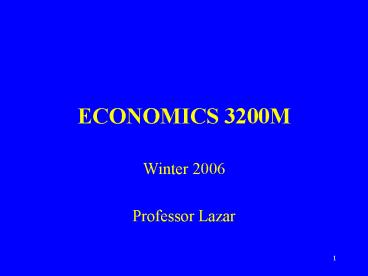ECONOMICS 3200M PowerPoint PPT Presentation
1 / 16
Title: ECONOMICS 3200M
1
ECONOMICS 3200M
- Winter 2006
- Professor Lazar
2
ECONOMICS 3200MLecture 1January 6, 2006
3
Course Requirements
- Three tests
- February 10 March 13 April
- 30 30 40
- Format 3 questions of 6 short essays
- Open book No cell phones, no wireless
communication devices - No excuses for missing first two tests see
Course Outline
4
Other Ground Rules
- No taping of lectures
- No cell phones in class
- Responsible for all chapters in text except
chapter 18 - Listen before you write Lecture notes for each
week will be posted by the end of the week
5
Office Hours
- Fridays 11-1
- N205J, Schulich
- Phone 736-5068
- Email flazar_at_yorku.ca
6
Text
- D.W. Carlton and J.M. Perloff, Modern Industrial
Organization, 4th Edition, Addison-Wesley, 2005
7
Objectives
- Focus of the course Examine real-world
competitive behaviour, and highlight the
theoretical limitations of traditional
microeconomic theories - Study different market structures
- Consider how these structures develop and evolve
over time - Implications for competitive behaviour
8
Disclosure Personal Bias
- Theoretical underpinnings of competition policy
and competition law have not yet incorporated the
work of Professor Michael Porter. Porters work,
which builds upon that of Joseph Schumpeter, one
of the great economists of the 20th century,
emphasizes that companies strive to create a
competitive advantage. - Those that succeed outperform their competitors
and are most likely to dominate their markets. - The laggards eventually exit the industry.
- Competition policy tends to inhibit companies
from freely developing competitive advantages
because the successful companies are likely to be
constrained in their ability to exploit their
advantages. - The long-run consequences of this are much more
significant than the supposed loses in consumer
welfare resulting from a reduction in the number
of unsuccessful competitors.
9
Disclosure Personal Bias
- According to Schumpeter, the competitive gales of
creative destruction, the product of
entrepreneurs, drive the capitalist system
forward and produce the dramatic improvements in
standards of living. - If one were to compare the top 25 companies on
the Fortune 500 list in 1970 and the list in
2005, one would find that there has been a
dramatic turnover in the list. - And in 35 years time the list will be much
different yet. - All of these changes have taken place and will
take place without the intervention of
competition policy.
10
Introduction
- Theory If, then
- If perfect competition, then PMC
- If monopoly, then, PgtAC
- If no entry barriers and zero exit costs, then
markets contestable and PAC - If economies of scale to Q0 and diseconomies of
scale beyond Q0 , then AC curve is U-shaped - If oligopoly, then ???
- If heterogenous product, then Monopolistic
competition - If economic profits, then entry occurs
11
Introduction
- Problem Many paths to the if, thus many paths
for then - Example Monopoly
- How was monopoly created?
- Government, natural monopoly, successful
strategies, superior management, luck - Entry barriers created as part of process?
- Depends on how monopoly created
- Strategies to sustain monopoly?
- Rent seeking public vs.private sector
12
Introduction
- Problem Competition
- Passive/active?
- Rivalry the goal of competition is to kill
your competitors - Compare to concept of competition in perfect
competition model - Michael Porter Determinants of rivalry
- Concentration and balance (Herfindahl-Hirschman
index, concentration ratios) facilitate
collusive behaviour, deter entry, dominant firm - Threat of entry, exit barriers
- Product differentiation brand identity,
switching costs, reputation - Informational complexity
- Intermittent overcapacity airlines, steel
- Bargaining power of buyers
- Industry growth
13
Introduction
- Problem Competition
- Michael Porter Competitive strategy
- Establish profitable and sustainable position
factoring in bargaining power of suppliers and
buyers, threat of entry, threat of substitutes,
intensity of rivalry - Strategies for achieving competitive advantage
- Cost leadership
- Differentiation
- Niche
- Role of management and luck
- Gamblers ruin and industry concentration
14
Introduction
- Problem Competition
- Sustainability of competitive advantage
- Barriers to imitation not insurmountable, thus
firm must create moving target by investing to
continually improve position - Well executed offensive strategy best defense
against attack by challenger - Role remains for defensive strategy increase
structural barriers to entry, increase
probability of retaliation retaliate when entry
attempted
15
Introduction
- Problem Market definition
- Identification of buyers, sellers potential
entrants, potential sources of supply - Geographic scope
- Local, regional, national, international
- Trade barriers, information
- What constitutes a substitute product?
- Cross-price elasticities measurement, critical
values - MRgt0 elastic range of demand curve, thus high
degree of substitutability with products that are
not included in market
16
Introduction
- Problem Market definition
- Entry barriers ease, speed of entry
- Entry by outsiders (who are they?) entry by
insiders - Height, perception of entry barriers
reputation,economies of scale/scope, learning
curves, access to distribution networks,
switching costs, firm specific capital (patents,
trade secrets, management skills, location) - Strategic behaviour of incumbents entry
accommodation or deterrence - Time period for defining markets time required
for adjustments in buyer/seller behaviour in
response to certain size price change

